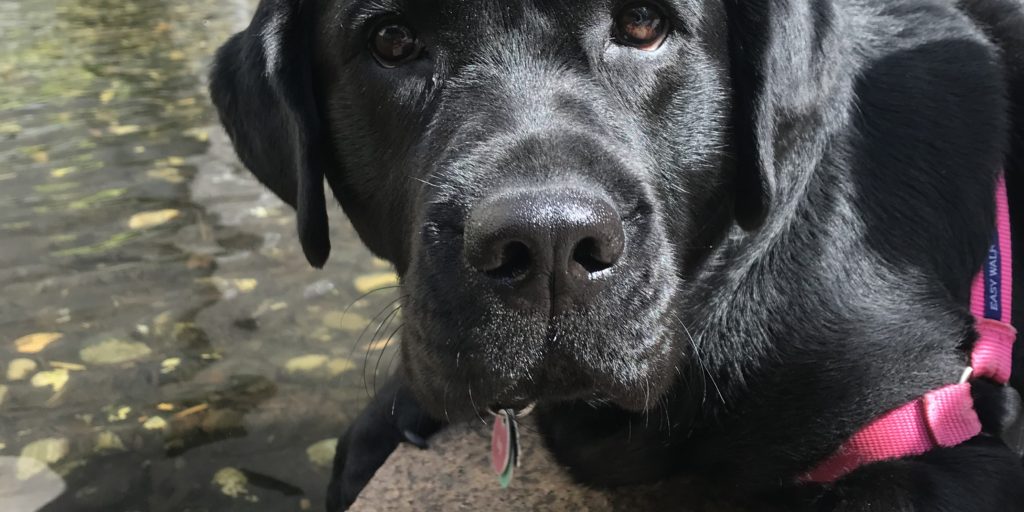Raising a puppy is not for the faint of heart. Raising one during a pandemic is even more daunting.
Ivy is a velvety black English Labrador Retriever. She is stocky in build, strong-willed in personality, and loving in manner. She bounded into our lives in early February, 2020. We were told to limit her interaction with other people, places, and pets until she had been fully vaccinated. We did that in full anticipation of the day when we could regularly walk her in parks and introduce her to humans and their dogs. That day did not arrive as quickly as we thought.
What came instead was full lockdown with three adults working, teaching, and schooling from the confines of a very small home. Along with Ivy, and our seven-year-old cat, we became an isolated pack. When awake, Ivy had one speed: fast. Her energy was boundless. Coming on the heels of our 13-year-old Golden Retriever, Roger, who died nine months earlier, Ivy was another breed of animal. She seemed to have no down-shift—until she slept. I lived for those moments in the early months, when for a brief time, motion stopped and the deep sound of her breathing was pure music to my ears.
When Roger died, I lost a dear friend. Not only was he my beloved pet, but he was also my teammate in pet therapy. I lost my connection to both the group, and to those we had visited. I found it hard to take a walk in the neighborhood without my faithful friend. Nine months after his passing, Ivy became our family pet, but, I still didn’t connect with her as a friend. I began to seriously doubt whether she and I would be able to visit as a pet therapy team the way Roger and I had. A therapy dog brings connection, love, peace, and physical touch. All the things required were now things to be avoided. I was raising a dog at a distance. The therapy group was on hiatus, the visiting sites shut down to us. Masks began to be commonplace. The invisible barrier that kept us 50 inches from other humans, was beginning to take its toll. The time when I should have been introducing Ivy to situations, sounds, and caresses was delayed.

Vet visits were challenging as I was required to remain in my car while a tech brought Ivy to see the doctor. But, she was brave and finally vaccinated to the point where she was able to venture away from the house. I began taking Ivy to a local park to help her get accustomed to new places, sights, smells. Walking for her was difficult. She preferred the hard pull; the darting from side to side (more than once taking me off my feet); the barking at other dogs and their owners as they passed us on the trails. She had a six-foot leash which marked the distance between us and other people. It was the distance which we’d been told would keep us safe. But distance is not what either of us wanted.
I was thankful to live in a neighborhood where she could hear the voices of other people. The fence between our house and the neighbor’s was a source of connection, as well as protection. I found as many ways as possible to socialize Ivy in the current environment: car rides, walks up and down our shared driveway, visits to more state parks. She continued to be full of an endless supply of energy. Solid in stature and strong as a bull, she greeted people with a bark that often had me explaining that she was just a puppy saying hello. Dog owners understood; others looked at us as ones to avoid.
When Ivy turned nine months old, I noticed a change. She was calmer. She slept more. I wondered if we had turned a corner. However, her calm demeanor came with a noticeable cough. I wondered at first whether it was a result of her pulling on the leash. I used a harness to take the pressure off of her neck, but the coughing continued. The vet’s initial diagnosis was kennel cough, but, after a round of antibiotics, the coughing continued. Vet visits became routine as she had blood drawn and numerous x-rays performed. She endured these events alone, having to be sedated as I remained banished to the car and unable to calm her. Her lungs were like those of a much older, sicker dog. With continued follow-up and medications, diagnostics and consultations, it was determined that she was probably suffering from lungworm. It is likely that she ate a slug, or licked its trail, which carried the worms that then found their way into her lungs and blood vessels. She was a very sick dog. After months of further isolation, treatment, and distance, she was finally released, but not without some residual lung damage. When she was healthy enough, we had her spayed. She couldn’t take long walks until her abdominal incision was completely healed and, once again, we found ourselves at home.

At the time of this writing, the little girl is 16 months old. She is strong and healthy; she is gentle and loving. Ivy and I have passed our Advanced Standard of Excellence for pet therapy and with more locations opening their doors, we’ve begun to visit at a retirement home and elementary school. She looks to me as her friend, and the feeling is mutual. While distanced from others, she and I drew close. While socially-distanced puppy-raising was not what I signed up for, Ivy and I made it through, day-by-day, and step-by-step.

